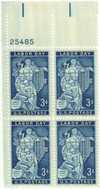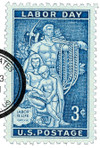
1956 3¢ Labor Day
# 1082 - 1956 3¢ Labor Day
$0.35 - $28.00
U.S. #1082
1956 3¢ Mosaic, AFL-CIO Headquarters
1956 3¢ Mosaic, AFL-CIO Headquarters
Issue Date: September 3, 1956
City: Camden, New Jersey
Quantity: 117,855,000
Printed by: Bureau of Engraving and Printing
Printing Method: Rotary Press
Perforations: 10 ½ x 11
Color: Deep blue
City: Camden, New Jersey
Quantity: 117,855,000
Printed by: Bureau of Engraving and Printing
Printing Method: Rotary Press
Perforations: 10 ½ x 11
Color: Deep blue
In honor of Labor Day, this stamp was released featuring a design from the mosaic mural at the AFL-CIO headquarters in Washington. The mural, called Labor is Life, was designed by artist Lumen Winter. Congress passed a law in 1894 designating the first Monday in September as a federal holiday called Labor Day. The First Day of Issue ceremony was, for the first time, preceded by a dedication ceremony both of which took place in the White House Rose Garden.
U.S. #1082
1956 3¢ Mosaic, AFL-CIO Headquarters
1956 3¢ Mosaic, AFL-CIO Headquarters
Issue Date: September 3, 1956
City: Camden, New Jersey
Quantity: 117,855,000
Printed by: Bureau of Engraving and Printing
Printing Method: Rotary Press
Perforations: 10 ½ x 11
Color: Deep blue
City: Camden, New Jersey
Quantity: 117,855,000
Printed by: Bureau of Engraving and Printing
Printing Method: Rotary Press
Perforations: 10 ½ x 11
Color: Deep blue
In honor of Labor Day, this stamp was released featuring a design from the mosaic mural at the AFL-CIO headquarters in Washington. The mural, called Labor is Life, was designed by artist Lumen Winter. Congress passed a law in 1894 designating the first Monday in September as a federal holiday called Labor Day. The First Day of Issue ceremony was, for the first time, preceded by a dedication ceremony both of which took place in the White House Rose Garden.










